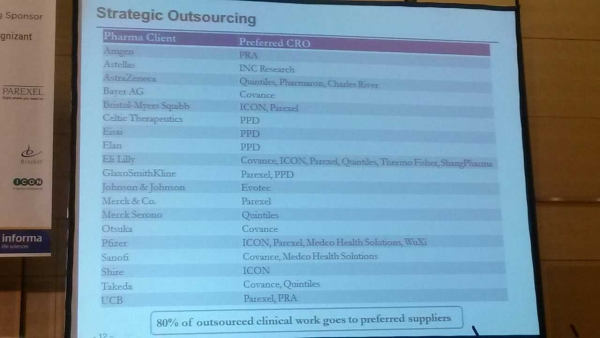Dispatches from PCT
Quintiles is the "arms, legs and brain" in Merck Serono's monogamous relationship

Just days after Quintiles went public in May 2013, the world’s largest contract research organization (CRO) signed a five-year deal to be the sole primary provider of Merck (known as EMD in North America) Serono’ clinical development. At last month’s Partnerships in Clinical Trials (PCT) Congress in Vienna, Austria, Merck Serono’s Global head of Clinical Strategy & Operations, Kathrin Schoenborn-Sobolewski, spoke exclusively about the relationship.
This partnership is a “first of its kind model for the industry,” she said, with “a biopharma and service provider coming together, allowing the service provider to use not just the arms and legs but the brain.”
The exclusive relationship benefits from an end-to-end approach, with Schoenborn-Sobolewski saying Quintiles is involved not only with the execution of a project, but with the strategy itself. “Quintiles has a seat at the table internally at Merck,” she said, whilst the pharma firm “has a dedicated unit at Quintiles.”
Such a close working relationship reduces the time needed to bring a product to trials, ensures consistency, and continuous improvement, she added, and the fact Quintiles is the sole provider allows “a higher and more predictable volume,” an “easier alignment on processes and standards”, and “simplified IT systems.”
Further details of the deal revealed at the conference included the fact this was not a risk-sharing agreement, Quintiles would be responsible for the selection of any third-parties, and this partnership did lead to a staff reduction at Merck Serono. Financial details were not disclosed when asked.
How the 'Oldest' met the 'Largest'
The move towards a sole strategic partner came about following Merck KGaA’s €10.4bn ($14bn) acquisition of Serono in 2006, and two years later the firm began its first strategic outsourcing project. However, this collapsed - Schoenborn-Sobolewski said - due to pipeline failures and the failure to commit to the model.
In 2011, the Merck Group began following its “Fit for 2018” transformation programme in order to improve overall efficiency before its 350th anniversary. Therefore, Schoenborn-Sobolewski said the firm took this as an opportunity to review its R&D outsourcing model and it discovered there was a need to enter a strategic partnership.
Though Merck Serono intended to have one or two partners, following a plan that began last year the firm received feedback and input that suggested the efficiency of end-to-end development could only be achieved with one partner and, Schoenborn-Sobolewski said “Quintiles was the one.”
Strategic Partners
Before Outsourcing-Pharma.com attended PCT, we invited readers to vote on whether they thought strategic partnerships were good for the CRO industry overall. 58% votes ‘yes’ whilst half that voted no and 13% were still undecided.
However, in another talk at PCT presented by Fairmount Partners Director Michael Martorelli and Paul Richter from Jina Ventures, the strength of preferred partnerships between the pharma world and its outsourcing partners became apparent.
As the picture of the slide below show, 80% of outsourced clinical work goes to preferred suppliers and most of the companies below rely on just one or two, though two of the biggest - Pfizer and Eli Lilly - do buck the trend.


















